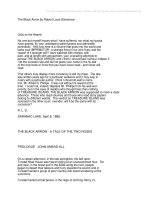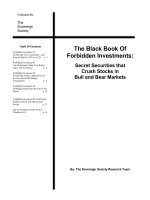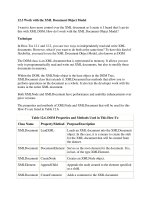CH13 the black scholes merton model
Bạn đang xem bản rút gọn của tài liệu. Xem và tải ngay bản đầy đủ của tài liệu tại đây (550.79 KB, 28 trang )
13.1
The Black-Scholes-
Merton Model
Chapter 13
13.2
The Stock Price Assumption
Consider a stock whose price is S
In a short period of time of length ∆t, the
return on the stock is normally distributed:
where µ is expected return and σ is
volatility
( )
tt
S
S
∆∆≈
∆
σµφ
,
13.3
The Lognormal Property
(Equations 13.2 and 13.3, page 282)
It follows from this assumption that
Since the logarithm of ST is normal, ST is
lognormally distributed
ln ln ,
ln ln ,
S S T T
S S T T
T
T
− ≈ −
≈ + −
0
2
0
2
2
2
φ µ
σ
σ
φ µ
σ
σ
or
The Lognormal Distribution
13.4
E S S e
S S e e
T
T
T
T T
( )
( ) ( )
=
= −
0
0
2
2
2
1
var
µ
µ σ
13.5
Continuously Compounded Return, x
(Equations 13.6 and 13.7), page 283)
,
2
or
ln
1
=
or
2
0
0
−≈
=
T
x
S
S
T
x
eSS
T
xT
T
σσ
µφ
13.6
The Expected Return
The expected value of the stock price is S0eµT
The expected return on the stock is
µ – σ2/2 not µ
This is because
are not the same
)]/[ln()]/(ln[
00
SSESSE
TT
and
13.7
µ and µ−σ2/2
Suppose we have daily data for a period
of several months
µ is the average of the returns in each day
[=E(∆S/S)]
µ−σ2/2 is the expected return over the
whole period covered by the data
measured with continuous compounding
(or daily compounding, which is almost the
same)
13.8
Mutual Fund Returns (See Business
Snapshot 13.1 on page 285)
Suppose that returns in successive years
are 15%, 20%, 30%, -20% and 25%
The arithmetic mean of the returns is 14%
The returned that would actually be
earned over the five years (the geometric
mean) is 12.4%
13.9
The Volatility
The volatility is the standard deviation of the
continuously compounded rate of return in 1
year
The standard deviation of the return in time
∆t is
If a stock price is $50 and its volatility is 25%
per year what is the standard deviation of
the price change in one day?
t
∆σ
13.10
Estimating Volatility from
Historical Data (page 286-88)
1. Take observations S0, S1, . . . , Sn at
intervals of τ years
2. Calculate the continuously compounded
return in each interval as:
5. Calculate the standard deviation, s , of the ui
´s
6. The historical volatility estimate is:
u
S
S
i
i
i
=
−
ln
1
τ
=σ
s
ˆ
13.11
Nature of Volatility
Volatility is usually much greater when the
market is open (i.e. the asset is trading)
than when it is closed
For this reason time is usually measured
in “trading days” not calendar days when
options are valued
13.12
The Concepts Underlying Black-
Scholes
The option price and the stock price depend
on the same underlying source of uncertainty
We can form a portfolio consisting of the
stock and the option which eliminates this
source of uncertainty
The portfolio is instantaneously riskless and
must instantaneously earn the risk-free rate
This leads to the Black-Scholes differential
equation
13.13
The Derivation of the Black-Scholes
Differential Equation
shares :
ƒ
+
derivative :1
of consisting portfolio a upset e W
ƒƒ
½
ƒƒ
ƒ
22
2
2
S
zS
S
tS
St
S
S
zStSS
∂
∂
−
∆σ
∂
∂
+∆
σ
∂
∂
+
∂
∂
+µ
∂
∂
=∆
∆σ+∆µ=∆
13.14
The Derivation of the Black-Scholes
Differential Equation continued
ƒ
ƒ
bygiven is in time valueitsin change The
ƒ
ƒ
bygiven is portfolio theof valueThe
S
S
t
S
S
∆
∂
∂
+∆−=∆Π
∆
∂
∂
+−=Π
Π
13.15
The Derivation of the Black-Scholes
Differential Equation continued
ƒ
ƒ
½
ƒƒ
:equation aldifferenti Scholes-Black get the to
equations in these and ƒfor substitute We
Hence rate.
free-risk thebemust portfolio on thereturn The
2
2
22
r
S
S
S
rS
t
S
tr
=
∂
∂
σ+
∂
∂
+
∂
∂
∆∆
Π∆=∆Π
13.16
The Differential Equation
Any security whose price is dependent on the
stock price satisfies the differential equation
The particular security being valued is determined
by the boundary conditions of the differential
equation
In a forward contract the boundary condition is
ƒ = S – K when t =T
The solution to the equation is
ƒ = S – K e–r (T – t )
13.17
The Black-Scholes Formulas
(See pages 295-297)
Td
T
TrKS
d
T
TrKS
d
dNSdNeKp
dNeKdNSc
rT
rT
σ−=
σ
σ−+
=
σ
σ++
=
−−−=
−=
−
−
1
0
2
0
1
102
210
)2/
2
()/ln(
)2/
2
()/ln(
)()(
)()(
where
13.18
The N(x) Function
N(x) is the probability that a normally
distributed variable with a mean of zero
and a standard deviation of 1 is less than x
See tables at the end of the book
13.19
Properties of Black-Scholes Formula
As S0 becomes very large c tends to
S – Ke-rT and p tends to zero
As S0 becomes very small c tends to zero
and p tends to Ke-rT – S
13.20
Risk-Neutral Valuation
The variable µ does not appearin the Black-
Scholes equation
The equation is independent of all variables
affected by risk preference
The solution to the differential equation is
therefore the same in a risk-free world as
it is in the real world
This leads to the principle of risk-neutral
valuation
13.21
Applying Risk-Neutral Valuation
(See appendix at the end of Chapter 13)
1. Assume that the expected
return from the stock price is the
risk-free rate
2. Calculate the expected payoff
from the option
3. Discount at the risk-free rate
13.22
Valuing a Forward Contract with
Risk-Neutral Valuation
Payoff is ST – K
Expected payoff in a risk-neutral world is
SerT – K
Present value of expected payoff is
e-rT[SerT – K]=S – Ke-rT
13.23
Implied Volatility
The implied volatility of an option is the
volatility for which the Black-Scholes price
equals the market price
The is a one-to-one correspondence
between prices and implied volatilities
Traders and brokers often quote implied
volatilities rather than dollar prices
13.24
An Issue of Warrants & Executive
Stock Options
When a regular call option is exercised the stock that is
delivered must be purchased in the open market
When a warrant or executive stock option is exercised
new Treasury stock is issued by the company
If little or no benefits are foreseen by the market the
stock price will reduce at the time the issue of is
announced.
There is no further dilution (See Business Snapshot
13.3.)
13.25
The Impact of Dilution
After the options have been issued it is not
necessary to take account of dilution when
they are valued
Before they are issued we can calculate
the cost of each option as N/(N+M) times
the price of a regular option with the same
terms where N is the number of existing
shares and M is the number of new shares
that will be created if exercise takes place









